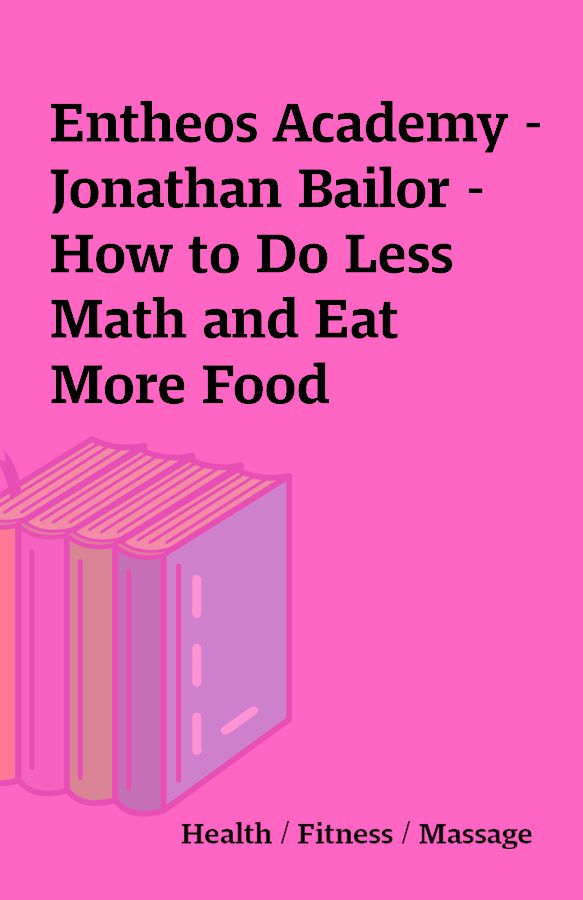Entheos Academy – Jonathan Bailor – How to Do Less Math and Eat More Food
Jonathan Bailor – How to Do Less Math and Eat More Food.mp4
[WebRip – 1 MP4]
Description
How to Do Less Math and Eat More Food: Simplifying Nutrition LabelsClass OverviewHave you ever wondered what the vitamin and mineral percentages on nutrition labels actually mean? Jonathan will debunk many nutritional myths, and talk about eating real food with less complex math.IntroductionHave you ever wondered what the vitamin and mineral percentages on nutrition labels actually mean? Ten percent of vitamin A. Hmmmm. Is that good or bad? Ten percent for a child? Ten percent for an adult? Ten percent for a woman? Oh gosh, I thought I was grocery shopping not taking a math test. These are wonderful questions to ask, because otherwise we may assume double-digit percentages mean the food is nutritious, and sadly, that’s frequently false. For example, let’s say you want to mix it up a bit during your next trip to the grocery store, and are looking to boost your calcium intake. You spot some goat’s milk, and consider giving it a whirl. You grab the carton, flip it around and see this label: 30 percent calcium. Traditionally you may consider this a “good source” of calcium. But is it? Should you give the good old goat a go? Maybe.The Top 10 Big Ideas 1 How Many Calories Will I Eat Along with That Nutrition? If I told you that 10 doughnuts are 10 times as nutritious as one doughnut, why would you think I was bonkers? Because you know that while you will get more nutrition in 10 doughnuts than you would in one, you will also get 10 times more low-quality calories, and that’s not worth it. You know that when looking at nutrition we have to also look at the number calories coming along with the nutrition. Consider the goat’s milk. We get 30 percent calcium in 150 calories. Let’s put that into perspective in terms of nutrition per calorie. If we moved a few aisles over and picked up some collard greens, we would see that we get more than double that amount of calcium in 150 calories, plus a startling amount of other vitamins and minerals. But what about vitamin A? 150 calories of the milk gives us 10 percent. 150 calories of collard greens gives us a whopping 665 percent. Vitamin C? 150 calories of the milk equals four percent. One hundred and fifty calories of the collard greens gives us 295 percent. You can see that considering nutrition per calorie changes the game a bit. Nutrition isn’t about the percentages you see on nutrition labels, it’s about those percentages relative to the calories in the food. That’s why 10 doughnuts aren’t more nutritious than one, and why we may now decide to go with the greens instead of the goat. 2 What Am I Trying to Do? The percentages we’re talking about have to do with “Daily Values” that were developed during World War II to prevent soldiers from dying. Avoiding death is a much different goal than optimal health and fitness. Unless you are satisfied with simply dodging death, making food choices based on “percent of Daily Value” may not be particularly useful for you. A more useful approach might be to ask… 3 Do I Really Need a Nutrition Label to Know if I Should Eat This? In the not too distant past nutrition labels were dramatically less common–and so was obesity, diabetes and heart disease. In fact, the most nutritious foods available frequently don’t have nutrition labels on them. For example, fresh vegetables, seafood, meat, and fruits, etc. What if, instead of doing math, we just ate food? I’ll define food as things we find in nature. What if the primary reason nutrition labels exist is because unnatural food-like products are so far from whole food that we have no way of knowing whether they are slightly unhealthy or extremely unhealthy without doing complex math? What if we said that generally speaking, if it doesn’t exist in nature, we would be better off eating something that does exist in nature? My vote: More real food, less complex math. 4 The more fiber the better If you have two options to choose from, all other things equal, the one with more fiber will burn more fat and boost your health better than the one with less. 5 The more protein the better Protein is the most satisfying of all the macronutrients and has consistently proved to be a fat-loss super star. But remember, not all sources of protein are the same. You will soon learn why and what to do about it. 6 The less sugar the better Sugar is toxic. Sugar is addictive. If the word sugar, or anything like it (see below) appears on the label, run…your life and long-term happiness depend on it. 7 The fewer ingredients the better Food doesn’t have ingredients. Food is an ingredient. It is a beautiful and perfect whole substance that kept us healthy and fit for the entirety of human history. If it’s not broke, let’s not break it. 8 The more vitamins and minerals per serving relative to calories per serving t If we don’t eat these essential substances, we get sick. It’s a simple as that. Micronutrient sufficiency is one of the most important and least appreciated aspects of optimal health. 9 If it include sweeteners, hydrogenated anything, or starch, try to avoid it. Don’t get fooled by fancy naming. Sugar by any other name is at least as harmful as sucrose (table sugar). Also, “hydrogenated” means poison. Not really, but practically Agave Nectar Barley Malt Beet Sugar Brown Sugar Buttered Syrup Cane Crystals Cane Juice Crystals Cane Sugar Caramel Carob Syrup Castor Sugar Confectioner’s Sugar Corn Sweetener Corn Syrup Corn Syrup Solids Crystalline Fructose Date Sugar Demerara Sugar Dextran Dextrose Diastatic Malt Diatase Ethyl Maltol Evaporated Cane Juice Fructose Fruit Juice Fruit Juice Concentrates Galactose Glucose Glucose Solids Golden Sugar Golden Syrup Granulated Sugar Grape Sugar High-Fructose Corn Syrup Honey Icing Sugar Invert Sugar Lactose Malt Syrup Maltodextrin Maltose Maple Syrup Molasses Muscovado Sugar Panocha Raw Sugar Refiner’s Syrup Rice Syrup Sorbitol Sorghum Syrup Sucrose Sugar Syrup Treacle Turbinado Sugar Yellow Sugar 10 Simplify: If You Can’t Find It Directly It Nature, Steer Clear Doesn’t it just make sense that the only foods available for us for 99.8% of our evolutionary history are what we should be eating? Life is complex enough. Let’s simplify where we can.
You must be logged in to post a review.






Reviews
There are no reviews yet.